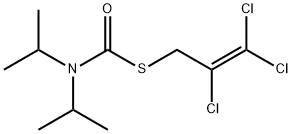| Identification | More | [Name]
Triallate | [CAS]
2303-17-5 | [Synonyms]
2,3,3-trichloro-2-propene-1-thiol diisopropylcarbamate
2,3,3-TRICHLOROALLYL-N,N-DIISOPROPYL-THIOLCARBAMATE
AVADEX BW
AVADEX BW(R)
CP 23426
Diisopropyltrichloroallylthiocarbamate
FAR-GO
FARGO(R)
S-(2,3,3-Trichloro-2-propenyl) bis(1-methylethyl)carbamothioate
S-(2,3,3-TRICHLOROALLYL)DIISOPROPYL THIOCARBAMATE
TRIALLAT
TRI-ALLATE
2,3,3-Trichlorallyl-N,N-(diisopropyl)-thiocarbamat
2,3,3-trichloro-2-propene-1-thiodiisopropylcarbamate
2,3,3-Trichloroallyl diisopropylthiocarbamate
2,3,3-Trichloroallyl N,N-diisopropylthiocarbamate
2,3,3-trichloroallyldiisopropylthiocarbamate
2,3,3-trichloroallyln,n-diisopropylthiocarbamate
2-Propene-1-thiol, 2,3,3-trichloro-, diisopropylcarbamate
Avadex BE | [EINECS(EC#)]
218-962-7 | [Molecular Formula]
C10H18Cl3NO2S | [MDL Number]
MFCD00078730 | [Molecular Weight]
322.68 | [MOL File]
2303-17-5.mol |
| Chemical Properties | Back Directory | [Appearance]
Oily liquid. Practically insoluble in water; soluble
in alcohol, acetone, ether, and heptane. Combustible. | [Melting point ]
29-30°C | [Boiling point ]
117°C (0.3 mmHg) | [density ]
1.273 | [refractive index ]
1.5320 (estimate) | [Fp ]
2 °C | [storage temp. ]
APPROX 4°C
| [solubility ]
Chloroform (Slightly), DMSO (Slightly), Ethyl Acetate (Slightly), Methanol (Slightly) | [form ]
neat | [pka]
-1.48±0.70(Predicted) | [color ]
White to off-white | [Water Solubility ]
4.0 g/mL | [Merck ]
13,9669 | [BRN ]
1875853 | [LogP]
4.600 | [CAS DataBase Reference]
2303-17-5(CAS DataBase Reference) | [NIST Chemistry Reference]
Triallate(2303-17-5) | [EPA Substance Registry System]
Triallate (2303-17-5) |
| Safety Data | Back Directory | [Hazard Codes ]
Xn;N,N,Xn,F | [Risk Statements ]
R22:Harmful if swallowed.
R43:May cause sensitization by skin contact.
R48/22:Harmful: danger of serious damage to health by prolonged exposure if swallowed .
R50/53:Very Toxic to aquatic organisms, may cause long-term adverse effects in the aquatic environment .
R36:Irritating to the eyes.
R20/21/22:Harmful by inhalation, in contact with skin and if swallowed .
R11:Highly Flammable. | [Safety Statements ]
S24:Avoid contact with skin .
S37:Wear suitable gloves .
S60:This material and/or its container must be disposed of as hazardous waste .
S61:Avoid release to the environment. Refer to special instructions safety data sheet .
S36:Wear suitable protective clothing .
S26:In case of contact with eyes, rinse immediately with plenty of water and seek medical advice .
S16:Keep away from sources of ignition-No smoking . | [RIDADR ]
UN 3077 | [WGK Germany ]
3 | [RTECS ]
EZ8575000 | [HS Code ]
29302000 | [Hazardous Substances Data]
2303-17-5(Hazardous Substances Data) | [Toxicity]
LC50 (96-hour) for rainbow trout 1.2 mg/L and bluegill sun?sh 1.3 mg/L (Hartley
and Kidd, 1987); acute oral LD50 of technical triallate for rats 1,100 mg/kg (Ashton and
Monaco, 1991), 1,471 mg/kg (RTECS, 1985). |
| Hazard Information | Back Directory | [General Description]
Colorless crystals or oily amber liquid. Toxic by inhalation, ingestion or skin absorption. Used as a pesticide. | [Reactivity Profile]
TRIALLATE is an organochlorine carbamate derivative. Carbamates are chemically similar to, but more reactive than amides. Like amides they form polymers such as polyurethane resins. Carbamates are incompatible with strong acids and bases, and especially incompatible with strong reducing agents such as hydrides. Flammable gaseous hydrogen is produced by the combination of active metals or nitrides with carbamates. Strongly oxidizing acids, peroxides, and hydroperoxides are incompatible with carbamates. | [Air & Water Reactions]
Readily hydrolyzed by strong base or acid. | [Health Hazard]
Highly toxic, may be fatal if inhaled, swallowed or absorbed through skin. Avoid any skin contact. Effects of contact or inhalation may be delayed. Fire may produce irritating, corrosive and/or toxic gases. Runoff from fire control or dilution water may be corrosive and/or toxic and cause pollution. | [Fire Hazard]
Non-combustible, substance itself does not burn but may decompose upon heating to produce corrosive and/or toxic fumes. Containers may explode when heated. Runoff may pollute waterways. | [Chemical Properties]
Oily liquid. Practically insoluble in water; soluble
in alcohol, acetone, ether, and heptane. Combustible. | [Uses]
Herbicide used to control wild oats in lentils, barley, peas and winter wheat. | [Uses]
Herbicide. | [Definition]
ChEBI: Tri-allate is a tertiary amine. | [Agricultural Uses]
Herbicide: Triallate is a pre-emergent or post-emergent herbicide used to control a variety of annual grasses and wild
oats on several grains, oilseed and vegetable crops. Its use
has been restricted to use in CO, ID, KS, MN, MT, NE, NV,
ND, OR, SD, UT, WA, and WY. Its use on canary grass
has been revoked. Not listed for use in EU countries
.
Registered for use in the U.S | [Trade name]
AVADEX BW®; BUCKLE®, (trial-
late + trifluralin); CP-23426®; DIPTHAL®; FAR-
GO®[C]; FAR-GO®; FORTRESS®; OVADEX BW® | [Environmental Fate]
Soil. In an agricultural soil,
14CO2 was the only biodegradation identified; however,
bound residue and traces of benzene and water-soluble radioactivity were also detected
in large amounts (Anderson and Domsch, 1980). In soil, triallate degrades via hydrolytic
cleavage with the formation of dialkylamine, carbon dioxide and mercaptan moieties. The mercaptan compounds are further degraded to the corresponding alcohol (Hartley and
Kidd, 1987). The reported half-life in soil is 100 days (Jury et al., 1987). |
|
|





